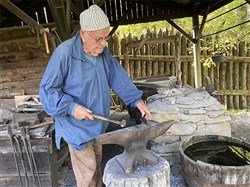VOL. 45 | NO. 48 | Friday, November 26, 2021
No need for horse, buggy to take a drive back in time
With COVID concerns and restrictions putting a crimp in the foreign travel to which we aspire, we recently decided instead to take a trip back in time.
Destination: 1840 or thereabouts.
This did not involve a Hot Tub Time Machine (though I wouldn’t mind having one). We just climbed into my Jeep and headed northeast a couple of hundred miles to the restored village in Pleasant Hill, Kentucky, once home to a colony of Shakers.
“Celibate chair-makers,” one long-ago resident feared they’d be remembered as. Which would be unfair, since they made lots more than chairs.
Beds, for instance. Dressers. Tables. Chests. Bookcases. Night stands. The legacy of craftsmanship endures among furniture makers to this day, with products prized by those whose tastes lean to simple lines and unadorned features. And whose pockets are deep enough to afford the tariff.
Brooms, I learned, were a major profit-maker for the colony. Hard to imagine them as an economic engine today, but vacuum cleaners were in short supply back then. They also did commerce in cooper wares, sundry preserves, packaged seeds and other goods.
For a Bible-based, socialist community living apart from mainstream society, they were quite the capitalists.
The celibate part was accurate, though, and a chief reason there are no Shakers at Pleasant Hill today. Nor have there been since 1923, when Sister Mary Settles, the last of the resident flock, transitioned to the next plane of existence at the age of 86. She’d been at Pleasant Hill since 1859.
It’s hard to sustain a movement that bars reproduction as a means of expansion, relying instead on converts from among the already-living.
Still, they did all right for a while. At its peak in the 1820s, Pleasant Hill was home to nearly 500 people. Nationwide, there were maybe 3,500 Shakers in the 1840s.
My knowledge of Shaker life before our visit was limited. I was familiar with the furniture style – undeniably attractive, but a bit spindly for my taste. I lean to Mission style. Stickley.
I also had a vague idea of the origin of the name, knowledge that has since been expanded.

Blacksmithing is one of several skills demonstrated at Shaker Village.
-- Photograph By Kayne RogersOfficially, they were the United Society of Believers in Christ’s Second Appearing. Offshoots of the Quakers, with some other influences mixed in, they were given to spontaneous and energetic movements during worship. They became known by outsiders as Shaker Quakers, not necessarily approvingly. That was later shortened. The Shakers, rather than taking offense, took to the new name.
Among their core beliefs, in addition to celibacy: Communal living, equality of race and sex, freedom from prejudice, pacifism and simplicity.
And, I would add, hard work.
With Sister Mary’s departure, the Shaker Village property moved into private hands. But in 1961, a nonprofit group was formed to reacquire the land and surviving buildings, and restore the site as a living memorial to Shakers past.
Today you can stay overnight in a former Shaker workshop, as we did, or hike trails in the village’s 3,000 tranquil, rolling acres. Basket weaving, needlework, rug-making and other demonstrations help transport visitors – mentally, at least – into a previous century.
Guided walks explore and explain different aspects of Shaker life, including, this month, a discussion of the impact of the Civil War on the community. (Hint: It was not positive.) Other occasional activities include marshmallow roasts, hayrides and bourbon tastings. You can even stage a wedding there. Shaker Village aims to please.
Halloween was the attraction during our visit, with parents delivering throngs of costumed small-fries for trick-or-treating. (I saw one kid dressed as – I’m pretty sure – Barney Fife.)
We also attended a demonstration of what worship services were like back in the day. (There was lots of foot-stomping involved.)
It was, all in all, a charming experience. And mind-stretching, as we tried to imagine the challenges and joys experienced by those utopian dreamers of so long ago.
Not all of whom are gone, apparently. Our tour guide said there are still four Shakers at Sabbathday Lake Shaker Village in Maine. Other sources say two.
In any event, that village is still accepting new members, provided they are American citizens ages 18-50, single, of “sound mind and body” and “completely free of debt.”
Good luck with that last requirement.
Shaker Village wasn’t the only time-travel feature of our trip, by the way. Nearby, Old Fort Harrod State Park is a faithful re-creation of the first permanent American settlement in Kentucky.
We learned about cloth weaving, blacksmithing and gun making from on-site enactors. Saw, but did not meet, the resident cat, Jinx.
The original fort dated from 1774, almost 250 years ago. Not a bad journey for a drive of three hours or so.
Joe Rogers is a former writer for The Tennessean and editor for The New York Times. He is retired and living in Nashville. He can be reached at [email protected]